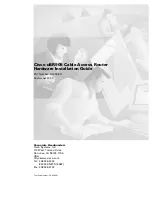
109
Glossary
Default Gateway (Router): Every non-router IP device needs a default
gateway. When the device sends out an IP packet, if the destination is
not in the same network, the device will send the packet to default
gateway, which will then forward it to the destination.
DHCP:
Dynamic Host Configuration Protocol. This protocol
automatically assigns an IP address for every computer in your network.
DNS Server IP Address: DNS stands for Domain Name System, which
allows Internet servers to have a domain name (such as
www.Broadbandrouter.com) and one or more IP addresses (such as
192.34.45.8). A DNS server will maintain a database of domain names
and respective IP addresses, so when a domain name is requested (like
typing “Broadbandrouter.com” in your Internet browser), the user will get
the corresponding IP address. The DNS server IP address used by the
computers on your home network is the location of the DNS server your
ISP has assigned to you.
DSL Modem: DSL stands for Digital Subscriber Line. A DSL modem
uses your existing phone lines to transmit data at high speeds.
Ethernet: A kind of standard of computer networks. Ethernet networks
are connected by special cables and hubs, and transfers data at up to
10/100 million bits per second (Mbps).
Idle Timeout: Idle timeout is designed so that after no traffic has been
transferred to the Internet for a pre-configured amount of time, the
connection will be disconnected automatically.
IP Address and Network (Subnet) Mask: IP stands for Internet
Protocol. An IP address consists four sets of numbers separated by
periods, which identifies a single, unique Internet computer host in an IP
network. Example: 192.168.2.1. It consists of 2 portions: the IP network
address, and the host identifier.
The IP address is a 32-bit binary pattern, which can be represented as
four cascaded decimal numbers separated by “.”: aaa.aaa.aaa.aaa,
where each “aaa” can be anything from 000 to 255, or as four cascaded
binary numbers separated by “.”:
bbbbbbb.bbbbbbbb.bbbbbbbb.bbbbbbbb, where each “b” can either be
0 or 1.
A network mask is also a 32-bit binary pattern, and consists of
consecutive leading 1’s followed by consecutive trailing 0’s, such as
11111111.11111111.11111111.00000000. Therefore sometimes a
Содержание nLite 3G-6200N
Страница 1: ...www sotmarket ru Edimax 3G 6200N 8 800 775 98 98...
Страница 2: ......
Страница 25: ...23 6 Click Next 7 Select I accept the terms in the license agreement and click Next...
Страница 26: ...24 8 If you want to change the destination folder please click Change Click Next to continue 9 Click install...
Страница 118: ...116...
Страница 119: ...2 Edimax 3G 6200N...









































